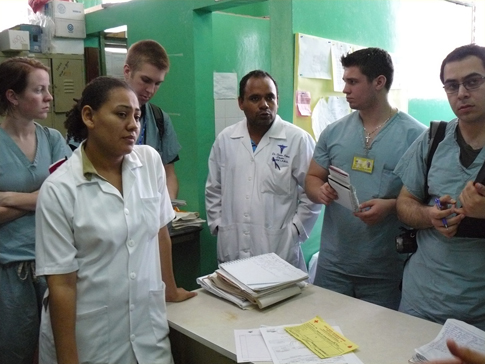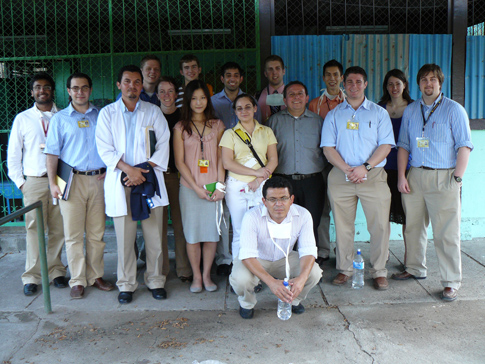ANN ARBOR, Mich.— After researching more than 600 health-related technologies and traveling to Nicaragua to observe medical care there, University of Michigan graduate students have identified five keys to developing sustainable health technologies in resource-limited settings such as developing nations.
About the image: Students interview Dr. Osman Palma (center), director of the Alfonso Moncada Guillen Hospital Amigo de la Niñez y de la Madre, located in Ocotal, Nicaragua. Photos courtesy of Kathleen Sienko, University of Michigan.
“Through their work, these students created new knowledge that is very valuable outside the classroom,” said Kathleen Sienko, an assistant professor of mechanical engineering who developed and taught the course.
The five successful engineering strategies the students identified are:
Keep it simple. The students observed that modest technologies, such as those with few moving parts, have fared better in the developing world than more sophisticated designs. Consider the Embrace infant warmer, which adopts the form and function of a sleeping bag to keep babies warm at a fraction of the cost of a traditional incubator. And a breath-based glucose monitor developed by the University of Florida eliminates the need for the costly test-strips that are commonly used in conventional blood glucose testing.
Teach. Some of the most sustainable implementations have been educational initiatives, such as a simple device fashioned from a cardboard box that is used to train doctors to perform laparoscopic surgery, or a necklace with colored beads that helps a woman keep track of her menstrual cycle for family planning purposes.
Get out there. Taking healthcare out of clinics and into the community is a tactic of many successful programs. The directly observed therapy short-course (DOTS) strategy used by the WHO to counter tuberculosis has helped ensure adherence to a treatment plan by involving a health worker who watches a patient take his or her medication each day. Another example are the Brigadistas, mobile medical brigades in Nicaragua, that bring healthcare to rural and outlying areas.
Sienko has observed that a common stumbling point for global health technologies is a lack of understanding by design engineers of the setting in which their technology will be used. The case study database developed by her class is an effort to aid in overcoming this problem.
“The design and development of health-related technologies for resource-limited settings requires a detailed consideration of the end user and target community that goes beyond the traditional engineering design needs assessment,” Sienko said. “In a broader sense, economic, social, and cultural constraints must be considered for successful implementation of technologies.”
The World Health Organization says this database will be valuable.
“We are very grateful for the support provided by the University of Michigan in the compilation of information on medical devices for global health concerns, which is very needed, particularly by developing countries,” said Adriana Velazquez Berumen, coordinator of diagnostic imaging and medical devices at the WHO.



5 comments on “Improving Global Health: Five Engineering Strategies”